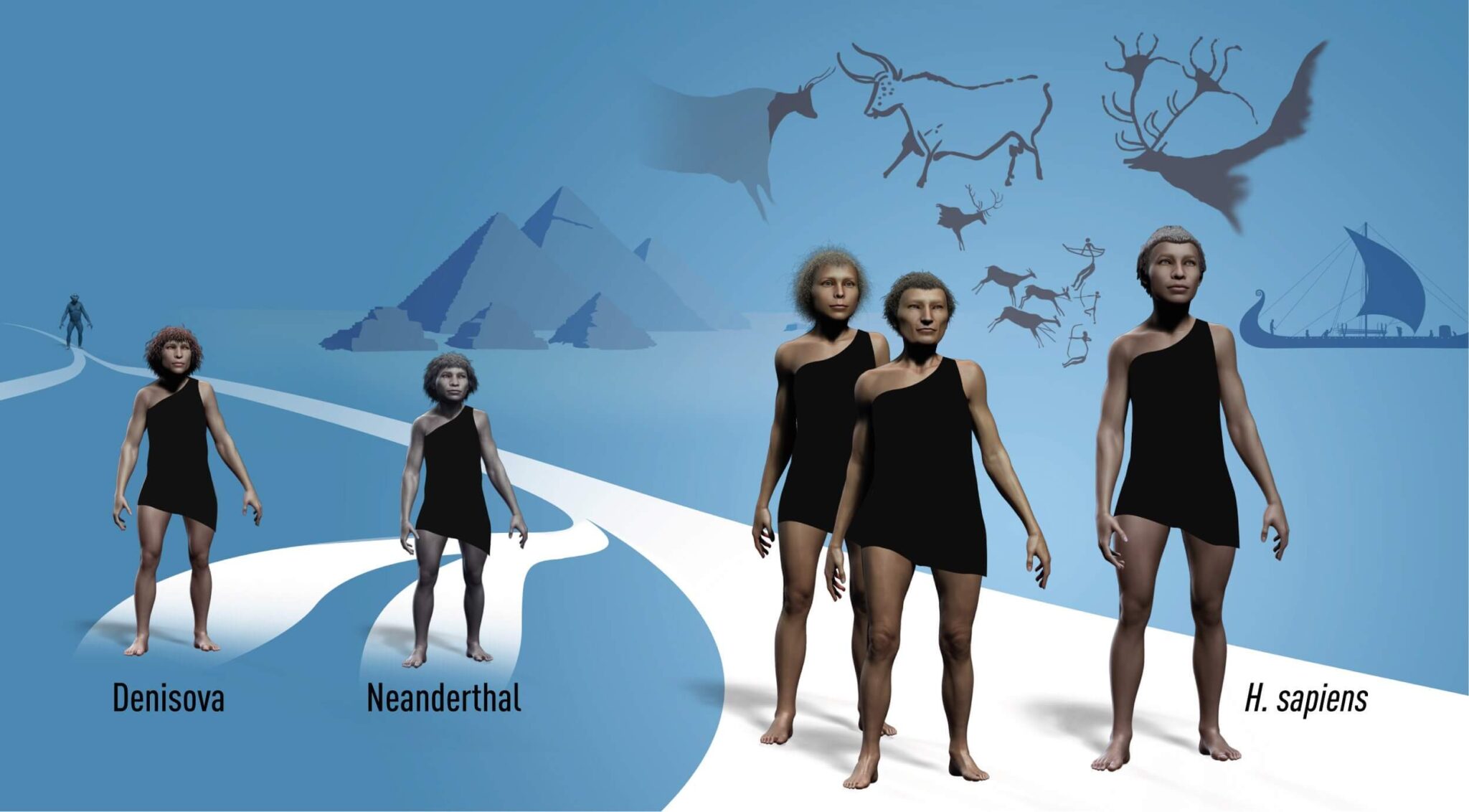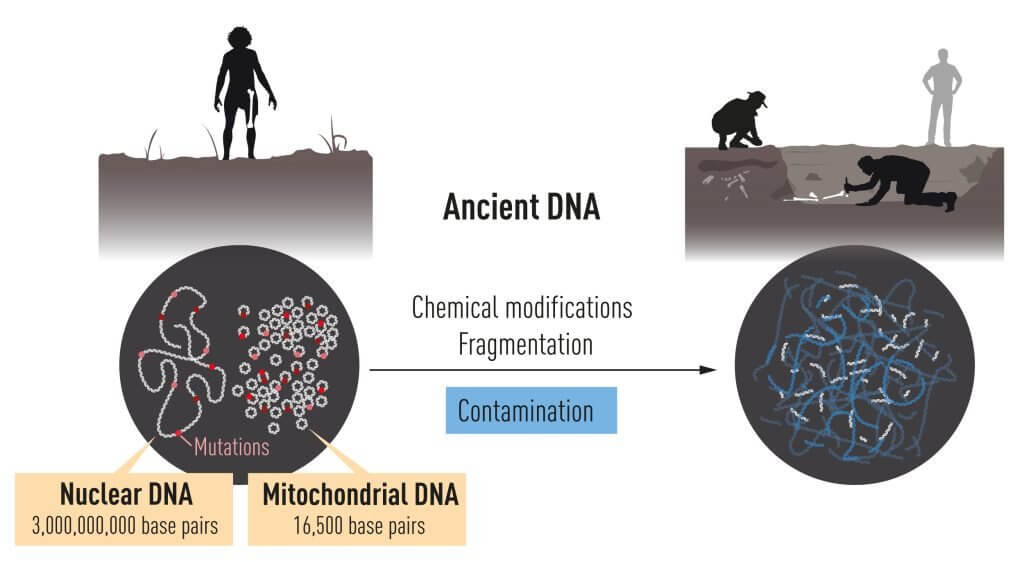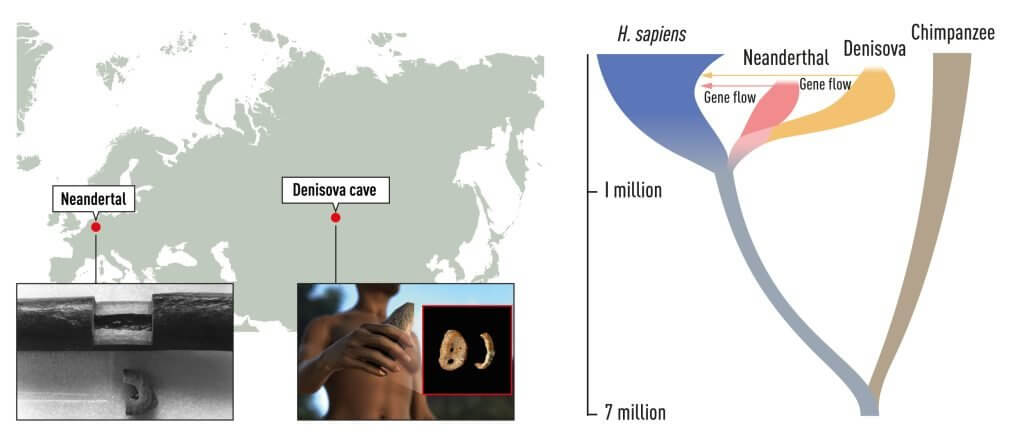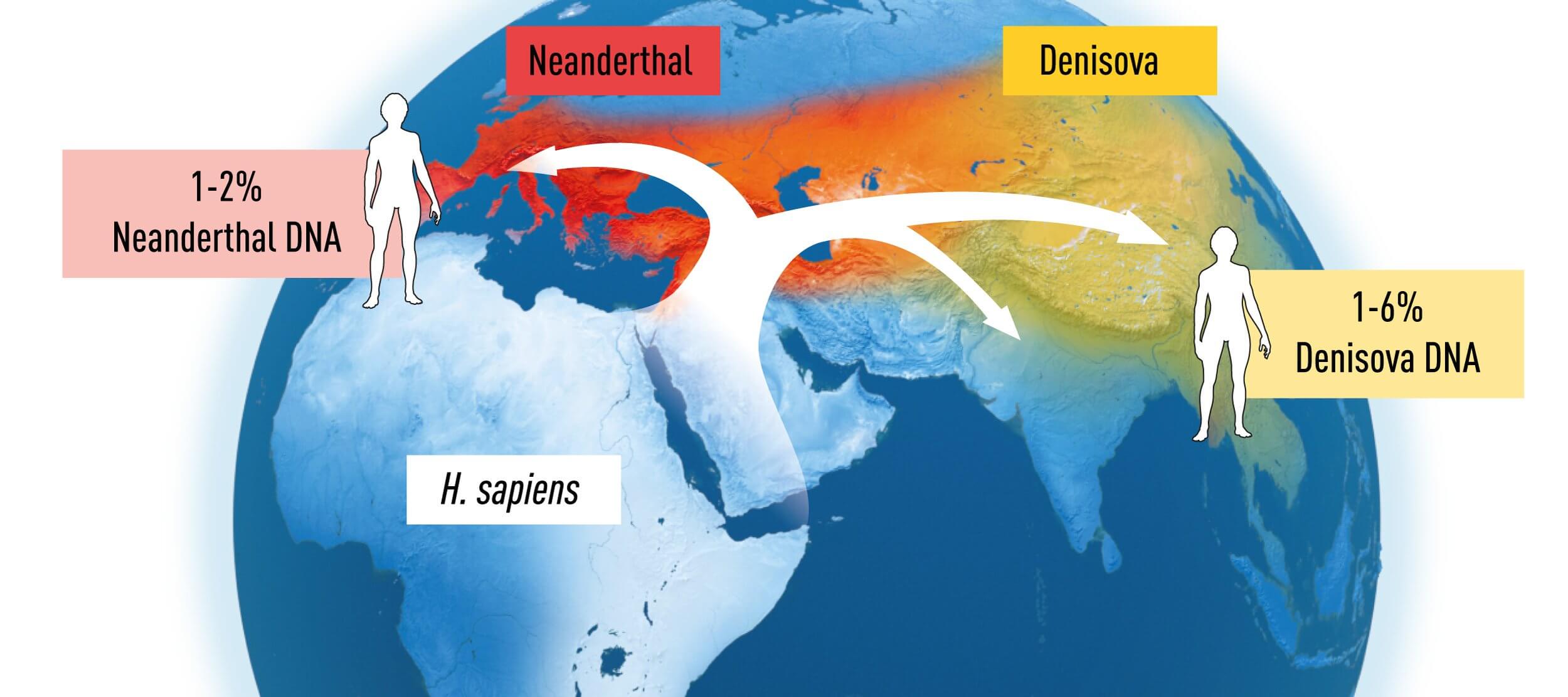Santa Febo, who also won the 2017 Dan David Prize, is a Swedish evolutionary geneticist, one of the founding fathers of the field of paleogenetics, leader of the international project to map the Neanderthal human genome, and co-discoverer of Denisovan man

The 2022 Nobel Prize in Physiology or Medicine was awarded to a single researcher, Svante Pääbo, for "his discoveries focusing on the genomes of the evolution of extinct hominins and humans".
In 2017, Svetna Pavo won the Dan David Prize, which is awarded in Israel and which was used in some cases as a Nobel Prize (Two of the researchers who strengthened the connection between the sciences and archeology won the Dan David prize for the dimension of past time).
Prof. Svante Pabo (Prof. Svante Pääbo), a Swedish evolutionary geneticist, is a world pioneer in the field of DNA sequence mapping of the ancient man and for being the first to extract and map the Neanderthal human genome - from fossils. Prof. Pabo laid the foundations for the field of genomic archeology research.
Pabo, who heads a genetics laboratory at the Max Planck Institute for Evolutionary Genetics in Leipzig, is one of the founders of the field of paleogenetics, the leader of the international project to map the Neanderthal human genome, and a partner in the discovery of Denisovan man - a species of man that differs in its genetic structure from Homo sapiens and Neanderthal man. He is not an archaeologist by training, but an expert in molecular biology, a graduate of Uppsala University in Sweden. In the early XNUMXs, he managed to obtain a sample from an Egyptian mummy in a museum in East Berlin and disproved the prevailing assumption until then that DNA decomposes quickly after the death of a person or animal and proved that it is possible to trace the pharaonic dynasties using the DNA of their dead.

Explain to the Nobel Prize Committee
The 2022 Nobel Prize in Medicine was awarded to a single researcher, Svante Pääbo, for "his discoveries focusing on the genomes of the evolution of extinct hominins and humans". Santa Febo is a Swedish evolutionary geneticist, one of the founding fathers of the field of paleogenetics, leader of the international project to map the Neanderthal human genome, and co-discoverer of Denisovan man.
The winner of the Nobel Prize for this year founded a completely new scientific field called "paleogenetics" (Paleogenomics). By revealing the genetic differences that characterize all living humans, starting with extinct hominins, his discoveries provide the basis for the study of the factors that make us unique human beings.
The Nobel Prize winner discovered that the transfer of genes took place from these extinct species of hominins to the species today called Homo sapiens, "scientific man" (scientific name: Homo sapiens, in Latin: "homo" - man, "sapiens" - thinker or intelligent). This ancient transfer of genes to humans today is of everyday physiological importance, for example, in the question of how our immune system responds to infections.
Through his groundbreaking research, the 2022 Nobel laureate achieved something that seemed impossible - sequencing the genome of Neanderthal man, an extinct species closely related to today's humans.
Mankind has always been curious about its origins. Where did we come from, and how are we related to those who were created before us? What makes us homospines different from other hominins?
Through his groundbreaking research, Santa Febo was able to achieve something that seemed impossible - sequencing the genome of the Neanderthal, an extinct species closely related to today's humans. In addition, he made the sensational discovery of uncovering a hominin species previously unknown to science, Denisova. In particular, Pébo also found that gene transfer occurred from these extinct hominins to homospines following migration out of the African continent about seventy thousand years ago. This ancient transfer of genes to humans today is of everyday physiological importance, for example, in the question of how our immune system responds to infections.
Fabo's unique research founded a completely new scientific field called "paleogenetics" (Paleogenomics). By revealing the genetic differences that characterize all living humans, starting with extinct hominins, his discoveries provide the basis for the study of the factors that make us unique human beings.
Where do we come from?
The question of the origin of human beings and the characteristics that make us unique arose already in ancient times. The research fields of paleontology and archeology are important for the study of human evolution. The research in these fields provided evidence that modern humans, the Homo sapiens, first appeared on the African continent about three hundred thousand years ago, while the Neanderthals, who developed outside the African continent and then inhabited Europe and Asia, appeared about four hundred thousand to thirty thousand years ago, and then became extinct. About seventy thousand years ago, groups of Homo sapiens migrated from Africa to the Middle East, and from there they dispersed to the rest of the world. From this it can be determined that Homo sapiens and Neanderthals coexisted in large parts of the Eurasian region for tens of thousands of years. But what do we really know about our interactions with the Neanderthals? Clues can be obtained from genomic information. By the end of the XNUMXs, almost the entire human genome had passed through the floor. This result is a tremendous achievement, and enables subsequent studies regarding the interrelationships between different human populations. However, the study of the interrelationships between humans living today and the Neanderthals will require the floor of genomic DNA derived from ancient samples.
A seemingly impossible task
Early in his career, Santa Febo was intrigued by the possibility of using modern genetic methods to study the DNA of Neanderthals. However, he soon realized that this is a very big technical challenge, in light of the fact that over time DNA changes chemically and even breaks down into shorter segments. After thousands of years, only tiny amounts of such DNA remain, and even this is highly contaminated with DNA originating from bacteria and contemporary humans (Figure 1). As a postdoctoral student, Pabo began developing methods for studying Neanderthal DNA, an effort that lasted several decades.

In 1990, Pavo was recruited to the University of Munich, where, as a new professor, he continued his research on ancient DNA. He decided to analyze DNA originating from Neanderthal mitochondria - organelles in cells that contain their DNA. The mitochondrial genome is small and contains only part of the genetic information in the cell, but it appears in thousands of copies, a fact that increases the chances of success. Using his updated methods, Pabo was able to sequence some of the mitochondrial DNA from a forty-thousand-year-old piece of bone. Thus, for the first time ever, researchers were able to perform the ancient floor up close. Comparisons with DNA from modern humans and chimpanzees demonstrated that the Neanderthal DNA was genetically distinct.
The floor of the Neanderthal genome
Since the tests of the small mitochondrial genome provided only limited information, Pabo now turned to the formidable challenge of sequencing the nuclear mitochondrial genome. During this period, he got the opportunity to found the 'Max Planck Institute' in Leipzig, Germany. At the new institute, Pabo and his team of researchers regularly improved the methods of isolating and testing DNA from ancient bone remains. The research team took advantage of innovative technical developments that made it possible to sequence DNA in a particularly efficient way. Pavo has also focused on a number of critical collaborations with experts in the areas of population genetics and advanced floor methods. His efforts bore fruit - Pabo completed the task that previously seemed impossible and published for the first time ever the genomic sequence of Neanderthals in 2010. Comparative tests proved that the last common ancestors of Neanderthals and Homo sapiens lived about eight hundred thousand years ago.

Pabo and his colleagues could now study the interrelationships between the Neanderthals and modern humans who originated in different parts of the world. Comparative tests showed that DNA sequences originating from Neanderthals were more similar to sequences from humans originating from Europe or Asia than those originating from Africa. This finding proves that Neanderthals and Homo sapiens interbred during the thousand years they lived alone. In modern times, it has been found that up to four percent of the genome of humans of European or Asian origin originated from Neanderthals (Figure 2).
A revolutionary discovery: Denisova
In 2008, a forty-thousand-year-old remains of a finger bone was found in Denisova Cave in southern Siberia. The bone contained well-preserved DNA, on which Pavo's researchers performed the floor analysis. The findings caused a scientific uproar: the tested DNA sequence was unique compared to all other known sequences taken from Neanderthals as well as from modern humans. Pabo discovered a species of hominins that was not known to science before, which was given the name 'Denisova'. A comparison with sequences originating from modern humans from different parts of the world showed that the transfer of genes also occurred between the Denisovans and Homo sapiens. These interrelationships were observed for the first time in populations originating from Melanesia (a group of islands in the Pacific Ocean northeast of the Australian continent) and in other parts of Southeast Asia, where the inhabitants contained up to six percent of Denisovan DNA.
Fabo's discoveries provided a new understanding of the history of human development. At the time when Homo sapiens began to migrate out of the African continent, at least two hominin populations, already extinct, were in Eurasia. Neanderthals lived in western Eurasia, while Denisovans inhabited the eastern parts of the continent. During the expansion of Homo sapiens out of Africa and their migration eastward, they not only encountered the native Neanderthals, but also the Dinosubi (Figure 3).
The field of paleogenetics Andits relevance
Through his ground-breaking research, Pavo founded an entirely new field of science, Paleogenetics. As a follow-up to his initial discoveries, his research group completed testing of several additional genome sequences from extinct hominins. Pabo's discoveries provided a unique resource, which was widely used by the scientific community in order to better understand the development and migration routes of humans over the years. Advanced and innovative genetic floor methods suggest that primitive hominins may also have interbred with Homo sapiens in Africa. At the same time, sequencing of genes from extinct hominins in Africa has not yet been carried out in light of the accelerated discharge of ancestral DNA in areas of tropical climate.
Thanks to Pabo's discoveries, we now understand that ancient DNA sequences from our extinct relatives also influence the physiology of modern humans. One such example is the Denisovan version of the EPAS1 gene, which confers a survival advantage at high altitudes and is common in present-day Tibetans. Other examples are Neanderthal genes that affect our immune system's response to various types of infections.

What makes humans unique?
Homo sapiens are characterized by their unique ability to create a complex culture, advanced inventions and figurative art, as well as their ability to cross oceans and spread to all parts of the world (Figure 4). Neanderthals also lived in groups and had large brains (Figure 4). They also used tools, but these developed only slightly over the hundreds of thousands of years. The genetic differences between homospines and their closest extinct relatives were unknown until they were discovered as part of Fabu's unique research. Vigorous research that is still ongoing focuses on testing the functional implications of these differences in light of the ultimate goal of finding the characteristics that make humans such a unique species.

Main publications
Krings M, Stone A, Schmitz RW, Krainitzki H, Stoneking M, Pääbo S. Neanderthal DNA sequences and the origin of modern humans. Cell. 1997:90:19-30.
Green RE, Krause J, Briggs AW, Maricic T, Stenzel U, Kircher M, Patterson N, Li H, Zhai W, Fritz MH, Hansen NF, Durand EY, Malaspinas AS, Jensen JD, Marques-Bonet T, Alkan C, Prüfer K, Meyer M, Burbano HA, Good JM, Schultz R, Aximu-Petri A, Butthof A, Höber B, Höffner B, Siegemund M, Weihmann A, Nusbaum C, Lander ES, Russ C, Novod N, Affourtit J, Egholm M, Verna C, Rudan P, Brajkovic D, Kucan Ž, Gušic I, Doronichev VB, Golovanova LV, Lalueza-Fox C, de la Rasilla M, Fortea J, Rosas A, Schmitz RW, Johnson PLF, Eichler EE, Falush D, Birney E, Mullikin JC, Slatkin M, Nielsen R, Kelso J, Lachmann M, Reich D, Pääbo S. A draft sequence of the Neanderthal genome. Science. 2010:328:710-722.
Krause J, Fu Q, Good JM, Viola B, Shunkov MV, Derevianko AP, Pääbo S. The complete mitochondrial DNA genome of an unknown hominin from southern Siberia. Nature. 2010:464:894-897.
Reich D, Green RE, Kircher M, Krause J, Patterson N, Durand EY, Viola B, Briggs AW, Stenzel U, Johnson PL, Maricic T, Good JM, Marques-Bonet T, Alkan C, Fu Q, Mallick S, Li H, Meyer M, Eichler EE, Stoneking M, Richards M, Talamo S, Shunkov MV, Derevianko AP, Hublin JJ, Kelso J, Slatkin M, Pääbo S. Genetic history of an archaic hominin group from Denisova Cave in Siberia. Nature. 2010:468:1053-1060.
Meyer M, Kircher M, Gansauge MT, Li H, Racimo F, Mallick S, Schraiber JG, Jay F, Prüfer K, de Filippo C, Sudmant PH, Alkan C, Fu Q, Do R, Rohland N, Tandon A, Siebauer M, Green RE, Bryc K, Briggs AW, Stenzel U, Dabney J, Shendure J, Kitzman J, Hammer MF, Shunkov MV, Derevianko AP, Patterson N, Andrés AM, Eichler EE, Slatkin M, Reich D, Kelso J, Pääbo S. A high-coverage genome sequence from an archaic Denisovan individual. Science. 2012:338:222-226.
Prüfer K, Racimo F, Patterson N, Jay F, Sankararaman S, Sawyer S, Heinze A, Renaud G, Sudmant PH, de Filippo C, Li H, Mallick S, Dannemann M, Fu Q, Kircher M, Kuhlwilm M, Lachmann M, Meyer M, Ongyerth M, Siebauer M, Theunert C, Tandon A, Moorjani P, Pickrell J, Mullikin JC, Vohr SH, Green RE, Hellmann I, Johnson PL, Blanche H, Cann H, Kitzman JO, Shendure J, Eichler EE, Lein ES, Bakken TE, Golovanova LV, Doronichev VB, Shunkov MV, Derevianko AP, Viola B, Slatkin M, Reich D, Kelso J, Pääbo S. The complete genome sequence of a Neanderthal from the Altai Mountains. Nature. 2014:505: 43-49.
>Svante Pääbo was born 1955 in Stockholm, Sweden. He defended his PhD thesis in 1986 at Uppsala University and was a postdoctoral fellow at the University of Zürich, Switzerland and later at the University of California, Berkeley, USA. He became Professor at the University of Munich, Germany in 1990. In 1999 he founded the Max Planck Institute for Evolutionary Anthropology in Leipzig, Germany where he is still active. He also holds a position as adjunct professor at Okinawa Institute of Science and Technology, Japan.
More of the topic in Hayadan:
- An Ancient Tooth of a Girl Discovered in a Cave Cracks the Mystery of Denisovan Man, a Brother Race of Modern Man
- The tip of a pinky, that's all the researchers from the Hebrew University needed to reconstruct what the Denisovan man looked like
- Decoding the genome has yielded evidence of hybridization between Homo sapiens and Neanderthal man
- Two of the researchers who strengthened the connection between the sciences and archeology won the Dan David prize for the dimension of past time (2017, one of them Prof. Pavo).

One response
A scientific article should use the correct term "species" of a person and not "species" of a person.